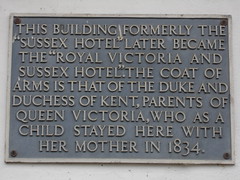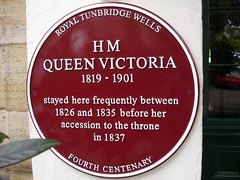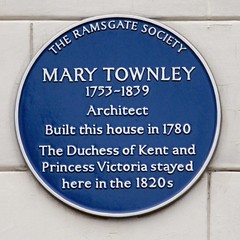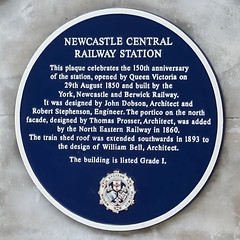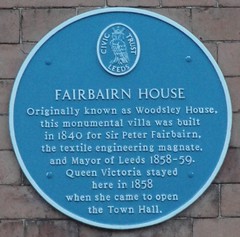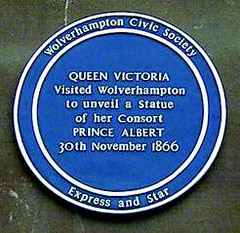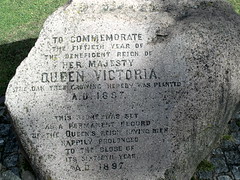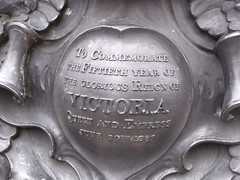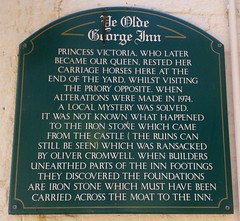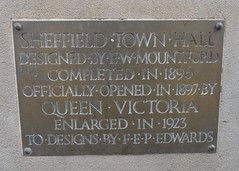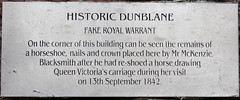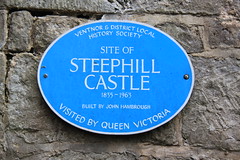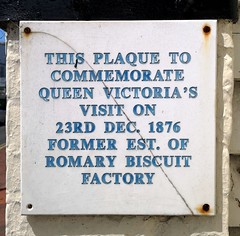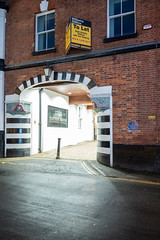Queen Victoria of the United Kingdom


Queen Victoria of the United Kingdom
(1819-1901)
woman, Princess of Kent (until 1837), Queen of the United Kingdom (1837-1901), and Empress of India (1876-1901)
Died aged 81
WikidataFamily tree
Commemorated on 27 plaques
Crown House 1828 The first house built by James Burton for his New Town of St Leonards Princess Victoria stayed here 1834 - 5
57 Marina, St Leonards, Hastings, United Kingdom where they stayed
This building, formerly the "Sussex Hotel" later became the "Royal Victoria and Sussex Hotel". The coat of arms is that of the Duke and Duchess of Kent, parents of Queen Victoria, who as a child stayed here with her mother in 1834.
The Pantiles, Tunbridge Wells, United Kingdom where they stayed
H M Queen Victoria 1819-1901 stayed here frequently between 1826 and 1835 before her accession to the throne in 1837
Hotel Du Vin, Crescent Road, Tunbridge Wells, United Kingdom where they stayed
This Regency building was formerly the The Royal Three Tuns Hotel visited in 1830 by Princess (later Queen) Victoria and her mother the Duchess of Kent.
Broad Street, Pershore, United Kingdom where they visited
Mary Townley 1753-1839 architect built this house in 1780. The Duchess of Kent and Princess Victoria stayed here in the 1820s
Farley's Ltd., Townley House, Chatham Street, Ramsgate, United Kingdom where they stayed
Newcastle Central railway station. This plaque celebrates the 150th anniversary of the station, opened by Queen Victoria on 29th August 1850 and built by the York, Newcastle and Berwick Railway. It was designed by John Dobson, Architect and Robert Stephenson, Engineer. The portico on the north facade, designed by Thomas Prosser, Architect, was added by the North Eastern Railway in 1860. The train shed roof was extended southwards in 1893 to the design of William Bell, Architect. The building is listed Grade 1.
Newcastle Central railway station, Newcastle upon Tyne, United Kingdom where they opened
Fairbairn House Originally known as Woodsley House, this monumental villa was built in 1840 for Sir Peter Fairbairn, the textile engineering magnate, and Mayor of Leeds 1858-59. Queen Victoria stayed here in 1858 when she came to open the Town Hall.
Clarendon Road, Leeds, United Kingdom where they stayed
Queen Victoria visited Wolverhampton to unveil a statue of her Consort Prince Albert 30th November 1866
HSBC Bank, Dudley Street, Wolverhampton, United Kingdom where they visited
Leeds Town Hall. This greatest of monuments to Victorian municipal government was opened by Queen Victoria on 7 September 1858. Its architect, Cuthbert Brodrick, created a civic palace with courts, council chamber, mayor's parlour, offices, bridewell and concert hall, the whole crowned by a magnificent tower.
Leeds Town Hal, Leeds, United Kingdom where they opened
This Guildhall stands on the site used for the Guild, or Fraternity, of Citizens established in 1387 by Richard II, which Guild continued for 161 years under 9 Monarchs, and was finally dissolved under Edward VI, in 1548. The present building was erected in 1846, by the Trustees of the Lichfield Conduit Lands, to whom the ancient Guild, in the year 1545, gave valuable properties out of their possessions to supply the citizens with water, and for their common weal. Her late Most Gracious Majesty, Queen Victoria, visited this City in 1832, and again in 1843. In 1894, His Majesty, King Edward VII, (as Prince of Wales), was received here on the Occasion of the Centenary of the Queen's Own Royal Staffordshire Yeomanry Cavalry.
The Guildhall, Bore Street, Lichfield, United Kingdom where they visited (1833-1842)
To commemorate the fiftieth year of the beneficent reign of Queen Victoria. This oak tree growing nearby was planted A.D. 1887. This stone was set as a permenant record of the Queen's reign having been extended to the close of it's sixieth year A.D. 1897.
Station Road / Lode Lane, Solihull, United Kingdom where they commemorated the Royal Jubilee (1887-1897)
To commemorate the fiftieth year of the glorious reign of Victoria Queen and Empress June 20th 1887
Statue of Queen Victoria - Castle Hill, Windsor, United Kingdom where they is commemorated (1887)
Victoria R and Albert visited this mount Sep. 6 1846. Whom God Preserve
St Michael's Mount, Marazion, United Kingdom where they visited (1846)
This house was once part of The Cock Public House - a well known coaching inn on the Great North Road. Bought by the Peppercorn family in 1845 and renamed 'The Manor House', the main buildings were demolished in the 1960s. Princess Victoria visited The Cock in the 1830s.
Peppercorns Lane, St. Neots, United Kingdom where they visited
Ye Olde George Inn. Princess Victoria, who later became our queen, rested her carriage horses here at the end of the yard, whilst visiting the priory opposite. When alterations were made in 1974, a local mystery was solved. It was not known what happened to the iron stone which was ransacked by Oliver Cromwell. When builders unearthed arts of the inn footings they discovered the foundations are iron stone which must have been carried across the moat to the inn.
2A Castle Street, Christchurch, United Kingdom where they was
Sandgate Castle. Commissioned for Henry VIII. Built 1539. Queen Elizabeth I rested here 28 August 1575. Queen Victoria and the Prince Consort visited 9 August 1855.
Castle Road, Sandgate, United Kingdom where they was
Sheffield Town Hall designed by EW Mountford. Completed in 1896. Officially opened in 1897 by Queen Victoria. Enlarged in 1923 to designs by FEP Edwards.
Town Hall, Pinstone Street, Sheffield, United Kingdom where they opened
Fake Royal Warrant On the corner of this building can be seen the remains of a horseshoe, nails and crown placed here by Mr McKenzie, Blacksmith after he had re-shoed a horse drawing Queen Victoria's carriage during her visit on 13th September 1842.
Stirling Road/Bridgend, Dunblane, United Kingdom where they was
Opened 21 May 1894 by Queen Victoria Manchester Ship Canal Engineer Sir Edward Leader Williams Centenary Year 1994
Trafford Road, Salford, United Kingdom where they was
Site of Steephill Castle. 1835 - 1963 Built by John Hambrough. Visited by Queen Victoria.
Castle Road, Ventnor, Isle of Wight, United Kingdom where they visited
Opened 21 May 1894 by Queen Victoria Manchester Ship Canal Engineer Sir Edward Leader Centenary Year 1994
Trafford Road, Salford, United Kingdom where they opened
In 1819-20 This house called Woolbrook Glen was occupied by the Duke & Duchess of Kent & the infant Princess Victoria now Queen of England Empress of India. It was also visited by H.R.H. Prince of Wales in 1856 and by H.R.H. The Duke of Edinburgh in 1881. H.R.H. The Duchess of Kent visited Sidmouth on 23 September 1986
Glen Road, Sidmouth, United Kingdom where they stayed (1818-1819)
(1) This stone is placed here by the parishioners and minister of Puttenham to commemorate the visit of Queen Victoria 7th day of July 1858 (2) Commemoration of The Queen's Diamond Jubilee 1897 (3) Restored for the commemoration of the coronation of Queen Elizabeth 2 (4) This plaque was unveiled by H.R.H, The Earl of Essex KG KCVO on 8th July 2008 to commemorate the 150th anniversary of the visit by Queen Victoria to Frowsbury Hill
Puttenham Golf Course, Puttenham, United Kingdom where they visited (1858)
This plaque to commemorate Queen Victoria's visit on 23rd Dec. 1876 former est. of Romary Biscuit Factory
26 Church Road, Tunbridge Wells, United Kingdom where they visited (1876)
Royal George Hotel Early coaching inn formerly the 'George and Dragon' Became 'Royal' following visit by Princess Victoria in 1832.
King Street, Knutsford, United Kingdom where they was
This Antient Cloth Hall was repaired by public subscription as a memorial to Queen Victoria Año Dom̃ 1902
Cloth Hall, Wharf Street, Newbury, United Kingdom where they was
The Queen rested here and partook of tea on Her Majesty's way from Balmoral by the Spital of Glenshee to Dunkeld 1st Oct 1866
, Kindrogan, United Kingdom where they rested (1866)


